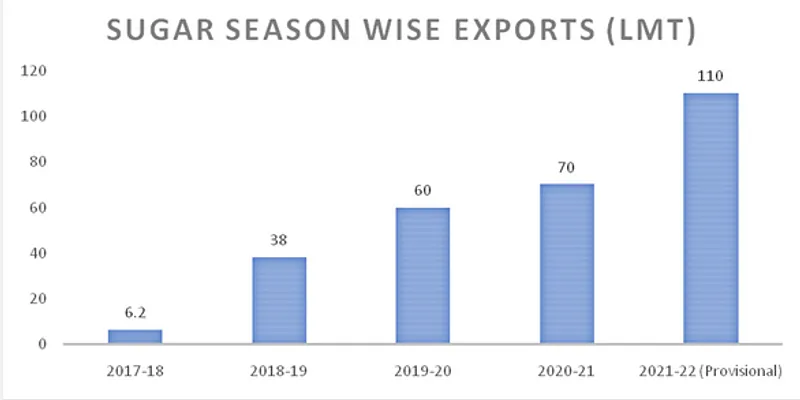India becomes largest producer, consumer of sugar; its second-largest exporter
The growth of ethanol as a biofuel sector in the last five years has been a boon for the sugar sector as the use of sugar for ethanol has led to sugar mills attaining better financial positions.
India has emerged as the world’s largest producer and consumer of sugar as well as the world’s second-largest exporter of sugar.
In the recently-concluded sugar season (October 2021 to September 2022), a record 5,000+ lakh metric tons (LMT) of sugarcane was produced in the country, out of which about 3,574 LMT of sugarcane was crushed by sugar mills to produce about 394 LMT of sugar (sucrose). Out of this, 35 LMT sugar was diverted to ethanol production and 359 LMT sugar was produced by sugar mills, according to information provided by the Ministry of Consumer Affairs, Food and Public Distribution.
It has been a watershed season for the Indian sugar sector as the industry made records in sugarcane production, sugar production, sugar exports, cane procured, cane dues paid, and ethanol production.
Another highlight was that the country recorded the highest exports of about 109.8 LMT—without any financial assistance which had been available till 2020-21. Supportive international prices and Indian government policy led to this feat of the Indian sugar industry. These exports earned foreign currency worth about Rs 40,000 crore for the country.
During the sugar season 2021-22, sugar mills procured sugarcane worth more than Rs 1.18 lakh crore and released payments of more than Rs 1.12 lakh crore with no financial assistance (subsidy) from the government.
Cane dues at the end of the sugar season were less than Rs 6,000 crore, indicating that 95% of cane dues have already been cleared. It is also noteworthy that for sugar season 2020-21, more than 99.9% of cane dues are cleared.

Image credits: PIB
The government has been encouraging sugar mills to use sugar for ethanol production, and also to export surplus sugar so that they may make payment of cane dues to farmers in time. This will also help mills improve their financial conditions and continue their operations.
The growth of ethanol as a biofuel sector in the last five years has been a boon for the sugar sector as the use of sugar for ethanol has led to sugar mills attaining better financial positions because of faster payments, reduced working capital requirements, and fewer blockage of funds due to less surplus sugar with mills, the government said.
During 2021-22, sugar mills/distilleries made a revenue of about Rs 18,000 crore from the sale of ethanol, which has also helped in the early clearance of cane dues of farmers, the consumer affairs ministry noted. The ethanol production capacity of molasses/sugar-based distilleries has increased to 605 crore litres per annum and the progress is still continuing to meet targets of 20% blending by 2025 under Ethanol Blending with Petrol (EBP) programme. In the new season, the diversion of sugar to ethanol is expected to increase from 35 LMT to 50 LMT which would generate revenue for sugar mills amounting to about Rs 25,000 crore.
There is an optimum closing balance of 60 LMT of sugar which is essential to meet domestic requirements for 2.5 months. The diversion of sugar to ethanol and exports led to the unlocking of the value chain of the whole industry as well as improved financial conditions of sugar mills leading to more optional mills in the ensuing season.
Edited by Kanishk Singh



.png?mode=crop&crop=faces&ar=16%3A9&format=auto&w=1920&q=75)



